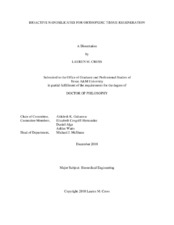| dc.description.abstract | Tissue engineering strategies incorporate cells and bioactive cues within a synthetic scaffold to mimic the biophysical and biochemical properties of native tissue to regenerate or repair damaged tissues and organs. A major challenge within tissue engineering is the use of supraphysiological doses of growth factors as bioactive cues to direct regeneration. The high concentrations of growth factors are often necessary for successful tissue regeneration due to short half-lives and protease degradation of growth factors; however, supraphysiological doses of growth factors have resulted in negative complications such as uncontrolled tissue growth, or cancer. To overcome this challenge, we have integrated cell biology, materials science, and bioengineering to develop a nanosilicate-based platform which can significantly reduce and potentially eliminate growth factor incorporation. Nanosilicates ([Na^+v0.7[(Mgv5.5Liv0.3)Siv8Ov20(OH)v4]^-0.7, Laponite XLG) are two-dimensional, charged particles with unique biochemical and biophysical properties. Here, we develop and utilize this platform for orthopedic tissue regeneration, establishing the unique properties of nanosilicates including their inherent bioactivity, ability to sequester and sustain release of therapeutic proteins, and incorporation into bioactive hydrogel scaffolds. Specifically, we utilize whole-transcriptome sequencing (RNA-seq) to holistically view human mesenchymal stem cell (hMSC) responses after treatment with nanosilicates to evaluate potential for stimulating both osteogenic and chondrogenic differentiation of hMSCs. We further investigated the mechanisms behind the innate bioactivity and reveal ionic dissolution products of nanosilicates (Li^+, Mg^2+, Si(OH)v4) stimulate osteogenesis in hMSCs. In addition to their inherent osteoinductivity, we utilize the surface charge of nanosilicate to sequester and locally delivery
growth factors for prolonged duration to demonstrate enhanced osteogenic differentiation in hMSCs. Finally, as we assess the potential of nanosilicate-based scaffolds for regeneration of interface osteochondral tissues by fabricating a gradient hydrogel. We show that cell morphology can be modulated along the gradient without the use of external growth factors. From these studies, we establish that this nanosilicate-based platform holds strong potential to engineer orthopedic tissues. | en |


